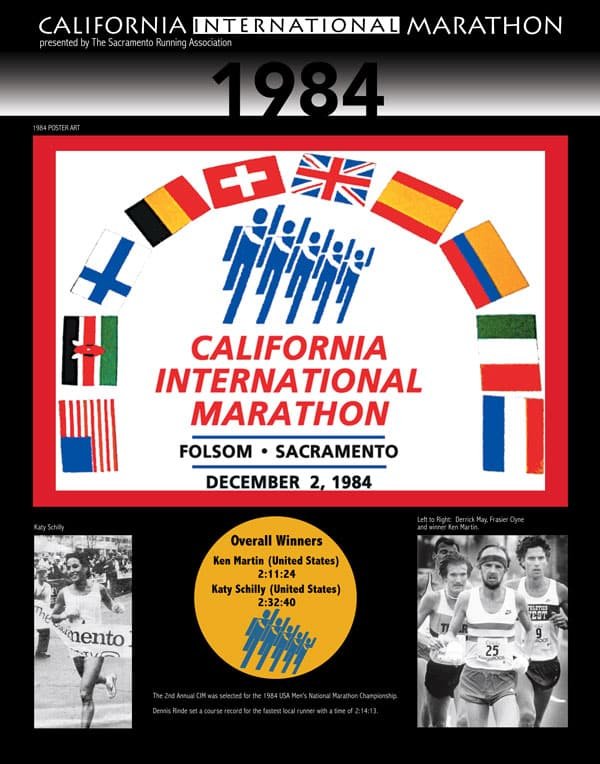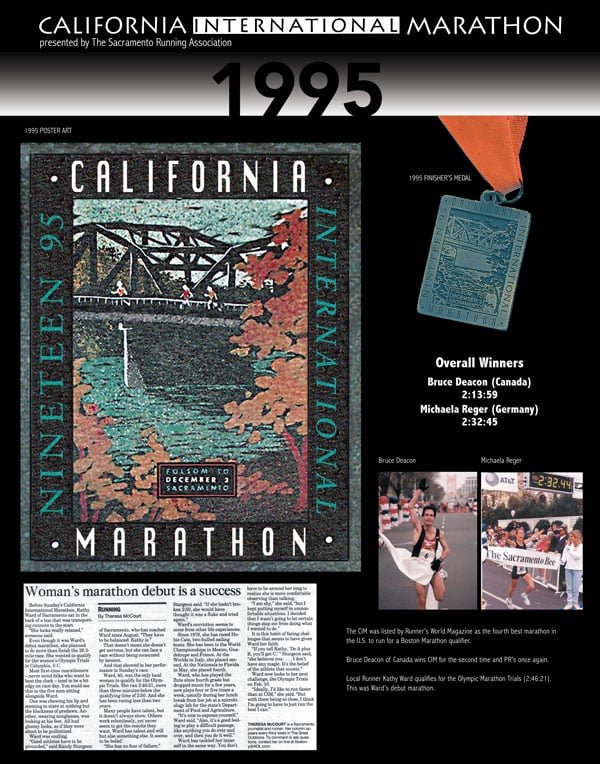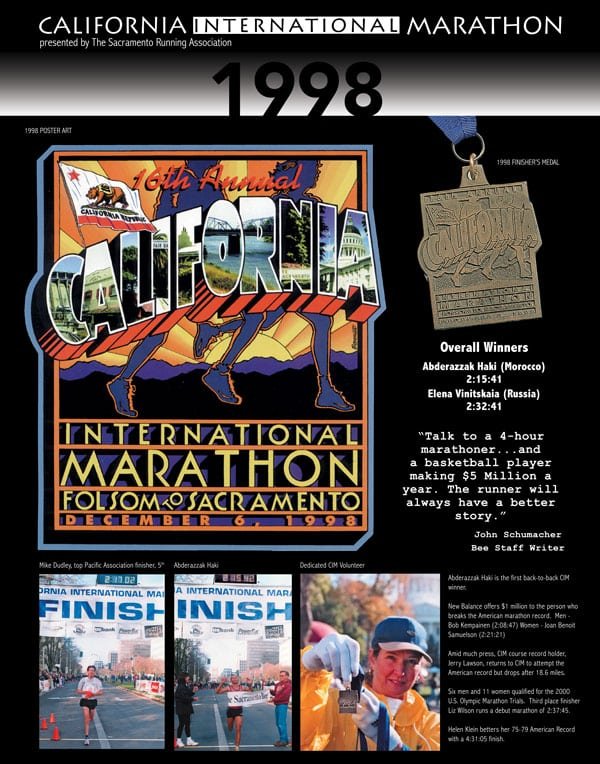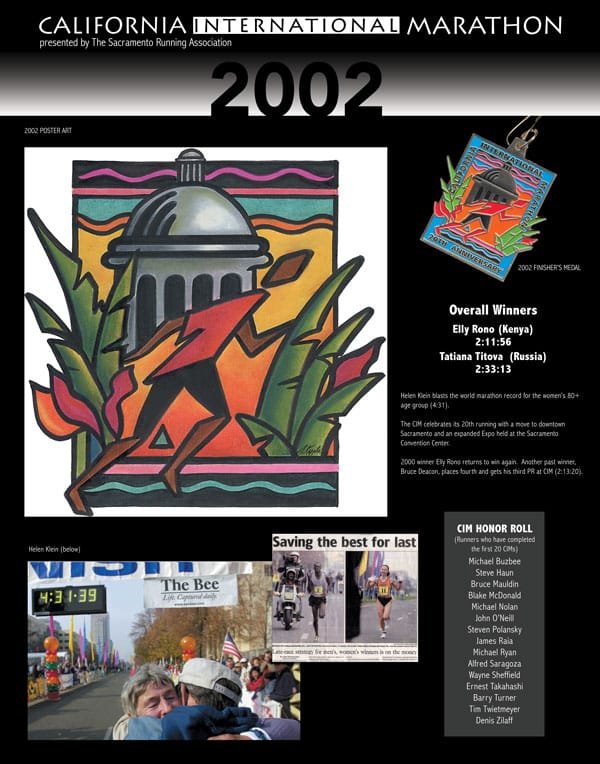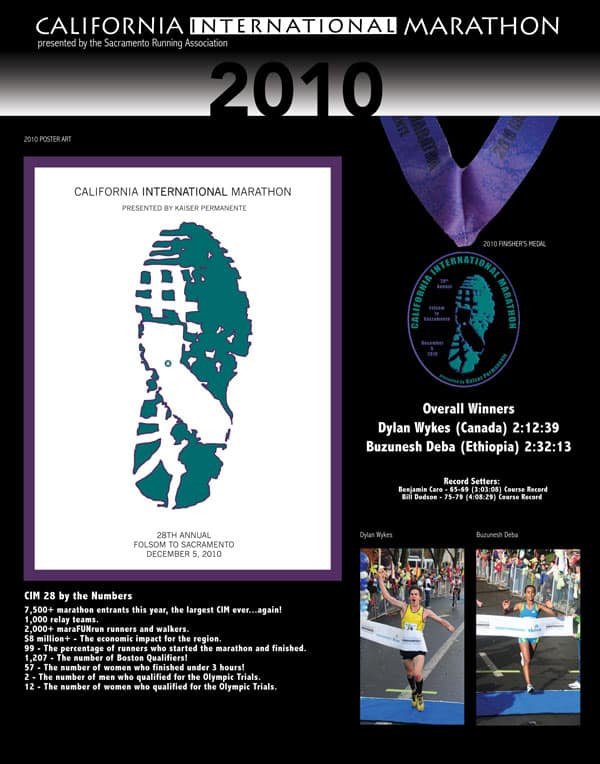
Dec. 8, 2024

The first California International Marathon came to life in 1983 when the Sacramento Running Association, founded by John Mansoor and Sally Edwards, established a course that retraces one of the area’s original gold miners’ routes. This unique and historic course remains essentially unchanged 40 years later. The 26.2-mile event begins in a rural setting near Folsom Dam and winds its way through the suburbs of Orangevale, Citrus Heights, Fair Oaks and Carmichael. As the route enters Sacramento, scenery includes the spectacular old growth trees ablaze with fall foliage, upscale residential areas along Fair Oaks Boulevard, and portions of the American River and Sacramento State University (home of the 2000 and 2004 U.S. Olympic Track & Field Trials). From 57th St. to 8th St., where runners make the final turn to the finish line, the cross streets provide a handy count down for the final miles. They will see the handsome traditional homes of the “Fabulous Forties,” from 49th St. to 40th St., and will run by historic Sutter’s Fort. They are now well within Sacramento’s busy midtown district lined with Sunday morning crowds who cheer the runners to their finish in the shadow of the spectacular State Capitol. The goals for the race established in its first year are the same today: offer a fast course with a net elevation drop, excellent runner service and prize money to attract top international, regional and local runners. More than 1,600 runners ran the first CIM, and the marathon and relay fields place more than five times that number of runners on the course today. The following pages contain a brief history of the CIM and highlights from 1983 through 2022.
CIM By the Numbers
Number of Finishers
Number of BQ's
Years of CIM
Race Miles Covered
Over
Potalets
Over
Safety Pins Given
Over
Gallons of Water
Total Miles by All Racers
The Early Years, 1983–1987
California’s premier performance marathon is born.
The inaugural California International Marathon was run in 1983 with 1,600 participants. Starting in Folsom and finishing at the State Capitol, the course used in the inaugural race has remained essentially unchanged for 35 years. The race was co-founded by John Mansoor and Sally Edwards and put on by the Sacramento Long Distance Running Association (later changed to the Sacramento Running Association, or SRA). To get the inaugural event off the ground, Mansoor, Edwards and the SRA received great help from key members of the community, including developers and philanthropists William Cummins and Angelo Tsakopoulos and board of supervisors chairman Ted Sheedy. The early years of the CIM were marked by instant credibility as a premier international marathon, with the race being awarded men’s and women’s national championship bids in 1984. Top professional runners started to come from all over the world to chase a major prize purse, and top names in the sport such as Jim Ryun, Craig Virgin and Frank Shorter got involved in the event as TV commentators in the early years.
1983
Inaugural race wasn’t decided until final mile with three late lead changes before Finland’s Marta Kilhoma became CIM’s first men’s champion in 2:13:35.
Gabriela Andersen-Scheiss of Switzerland became CIM’s first women’s champion in 2:33:25.
Sister Marion Irvine ran 2:51:01 at age 54 to qualify for the U.S. Olympic Trials. She remains the oldest woman to ever qualify for the Olympic Trials.
1984
CIM awarded U.S. Men’s and Women’s Marathon Championships.
Dennis Rinde ran 2:14:13 to set still-standing record for fastest time by a local runner at CIM.
Becoming More Than a Marathon,
1988–1992 The CIM becomes a major community event and civic amenity.
As the CIM gained notoriety as a running event, the SRA expanded its mission and used the event to engage and impact the greater Sacramento community. The CIM added a 2.62mile MaraFUNrun (1988) and a four-person Relay Challenge (1991) to its slate of race day events as a way to involve more people in the excitement of the CIM. With these added events and the addition of key community partners, the CIM quickly became more than a marathon and cemented its place in the community fabric as one of Sacramento’s great civic amenities.
1988
CIM served as the Master’s National Championship event.
A 2.62-mile MaraFUNrun event was added.
1991
Surprise win by unknown Canadian Bruce Deacon, which was the first of three CIM wins over an 11-year span.
England’s Sally Eastall became first woman to break 2:30 at CIM (2:29:29).
Runners earned free pizza for beating local pizzeria owner Pete Treleven.
1992
Steve Plasencia and Keith Brantly were separated by only 1 second in closest CIM finish ever.
40-year-old Pierre Levisse of France posted fastest masters time in world and placed fourth with 2:15:35.
Faster, Bigger and Better, 1993–2002
Course-record times, an influx of top African runners, and eyes on Boston help the CIM become known as “The Fastest Course in the West.”
The CIM continued its trajectory toward becoming “The Fastest Course in the West” in 1993 when Jerry Lawson torched the streets of Sacramento with a still-standing course-record of 2:10:27. Lawson’s time was the fastest American marathon in 1993. Sacramento-area runner Linda Somers won the women’s race that year to become U.S. Marathon Champion. Lawson’s and Somers’ great performances were followed by a string of foreign champions on both the men’s and women’s side, including six champions from African countries and a women’s course record (2:29:21) by Australian Nickey Carroll in 1999, truly making CIM a world-class event.
In 1994 when Runner’s World touted the CIM as one of the top marathons in the country in which to earn a qualifying time for the prestigious Boston Marathon, the CIM quickly attracted amateur runners from all over the country looking for a personal best time. The CIM then became one of the first marathons in the country to add an official pace team in 2001, as official pacers helped runners achieve Boston Qualifiers. The CIM was now a performance-oriented event for both professional and amateur runners alike.
1993
Jerry Lawson broke course record (2:10:27) and ran fastest American marathon of the year.
Local runner Linda Somers won U.S. Women’s Marathon Championship at CIM.
Local runner Rich Hanna qualified for U.S. Olympic Trials with 2:17:51.
1999
Joe LeMay won men’s title and earned “A” Standard for U.S. Olympic Trials.
Australian Nickey Carroll set women’s course record in 2:29:21.
Managing Growth, 2003–2007
The CIM rides the wave of industry growth and becomes one of the nation’s largest marathons.
The 2000s were a time of great growth for running events and the CIM was no exception. Participation in the marathon grew from less than 4,000 registrants in 2002 to nearly 8,000 registrants by 2007. The MaraFUNrun and Relay Challenge both saw huge growth during this period as well. With the increase in participant numbers and public interest, the pre-race packet pick-up at the headquarter hotel grew into a Health and Fitness Expo and was moved to the Sacramento Convention Center, attracting more than 20,000 people and featuring 70+ vendors and exhibitors.
In 2004 race organizers moved to chip timing and extended the finish line cutoff time by 30 minutes to accommodate event growth.
2003
Iraqi runner Ali Hamdan Hashim Al-Bahadly, 16, completed CIM and was first Iraqi athlete to compete in international competition as part of effort to reconstruct Iraqi Olympic Committee.
Eight runners qualified for 2004 U.S. Olympic Trials.
To Capacity and Beyond, 2008–2016
The CIM becomes an event in high demand; organizers continue to find ways to make the CIM a first-class runner’s race.
As the CIM approached its 30th anniversary, the running event industry was at the crest of significant growth. New running events were popping up all over the country, existing marathons added half-marathons to boost participation, and venture capital, private equity and charities began cashing in on the heavy participant growth in running events. The SRA decided to pass on the half-marathon “cash grab” and kept the marathon distance as its headline event. The SRA has been rewarded for that decision with the continued recognition of the CIM as one of the United States’ premier marathons.
With runners flocking from all over the world looking for a true runner’s race, the CIM continues to sell out every year, and race organizers have worked to make it the best marathon experience possible. They added a guaranteed entry process to give runners who are chasing a Boston Marathon qualifying time the chance to have a guaranteed late entry into the race. Race organizers also amplified runner amenities to help aid performance and make the CIM a runner-friendly race.
2011
A record 32 runners qualified for 2012 U.S. Olympic Trials at CIM, including local runners Tim Tollefson and Megan Daly.
2012
30th annual CIM had record number of registrations.
Daniel Tapia and Alisha Williams became first American duo to win CIM since 1993.
2013
Temperatures below 30 degrees at the start made for the coldest CIM ever.
American Becky Wade had sensational debut marathon to win in 2:30:41.
Fourteen runners qualified for the 2014 U.S. Olympic Trials.
CIM included inspirational tributes to victims, survivors and families of Boston Marathon bombing and Sandy Hook Elementary School shooting.
2015
18 runners qualify for 2016 U.S. Olympic Trials making CIM the leading qualifying race in the nation .
”The Performance Factory”, 2017–2019
CIM cements its place as the nation’s best performance marathon.
As CIM entered its 35th year, it was awarded a two-year run to serve as the US Marathon Championship. CIM was also featured in “Boston: The Documentary” as the top Boston Marathon qualifier on the west coast. These two dynamics led to a flood of performance runners coming from all over to gain coveted and increasingly scarce spots on the starting line of what was becoming known informally at “The Factory” for fast times, Boston qualifiers, Olympic Trials qualifiers, and personal bests. The 2017 to 2019 editions of CIM didn’t disappoint these “mark chasers”, as they went down in history as some of the deepest American marathons of all time in terms of performances, and shattering all Olympic Trials qualifying records, as well as world records for depth of performance.
2017
35th annual CIM had record participation and runners were treated to special anniversary swag
Timothy Ritchie and Sara Hall were crowned
USATF Marathon Champions
A record 91 runners earned qualifying standards for the 2020 U.S. Olympic Trials.
CIM earned Gold Level certification by the Council for Responsible Sport and earned national recognition from the Green Sports Alliance for its sustainability efforts
2018
Bates ran unsponsored wearing a jersey raising awareness for the victims of the Camp Fire that devastated nearby Butte County in the fall of 2018
A new record 153 runners earned qualifying standards for the 2020 U.S. Olympic Trials.
CIM broke a world record for performance depth for women by having the fastest ever recorded marathons for places 93rd and beyond.
Local marathoner, Brendan Gregg finishes 5th place in 2:13:28 and records fastest ever men’s time at CIM by a Sacramento-area native.
CIM cracks 8,000 finishers and 2,000 Boston qualifiers for the first time.
2019
Local marathoner, Jane Kibii, wins the women’s race in 2:29:31 and records the fastest ever women’s time at CIM by a Sacramento-area runner.
Over 100 runners earned 2020 U.S. Olympic Trials qualifying standards bringing CIM’s quadrennium total to 319 qualifiers – the most of any marathon in the world.
COVID and beyond, 2020-Present
The 38th annual California International Marathon, scheduled to run Sunday, Dec. 6 2020, was canceled due to health and safety guidelines associated with the COVID-19 pandemic. All 2020 CIM registrants received a voucher for free registration into either the 2021, 2022, or 2023 CIM. Race organizers also launched the “Project 26.20” virtual platform that featured training incentives and a race day virtual experience.
2021 marked a very successful “Comeback Year” for CIM, as the 38th edition featured over 8,000 finishers participating with modified race operations to comply with county health protocols in place at the time. Event organizers overcame unprecedented challenges, as the event was one of the first large-scale mass participation events in Sacramento since the COVID-19 pandemic began in 2020. It ended up being the 5th largest marathon in the United States in 2020 behind New York, Chicago, Boston, and Los Angeles.
2021
Local marathoner, Brendan Gregg wins the men’s marathon in 2:11:21 and breaks the record for fastest time ever run by a local athlete at CIM
Sara Vaughn of Boulder, CO wins the women’s race in 2:26:53 breaking the CIM course record by 40 seconds. It was Vaughn’s first-ever marathon, making the mother of 4 America’s 5th fastest marathon debutant in history.
Sustainability Fun Facts!
- Gold Level Sustainability certification – Council for Response Sport
- 75% of race week waste diverted from local landfills
- 35 sustainability stations each year – (trash, recycle, compost)
- 55 water monsters
- Eliminated single-use plastic water bottles (30,000 a year)
- 40 clean natural gas buses
- 90,000 compostable Nuun cups a year (since 2019)
- Mylar heat sheets exchanged for useable finishers jackets – 8,000 jackets per year since 2018
- Partner with Terracycle to recycle nutrition wrappers into benches and backpacks
- Partner with Goodwill Industries to divert 4,000 pounds of clothes away from landfills each year
- Cutting down on greenhouse gases – free rides on race weekend from Sacramento Regional Transit and free bike parking courtesy of SABA



